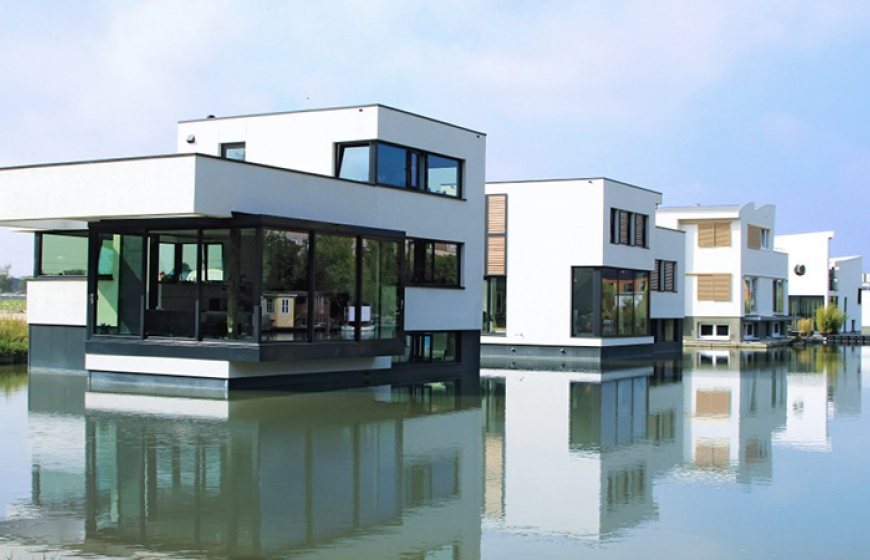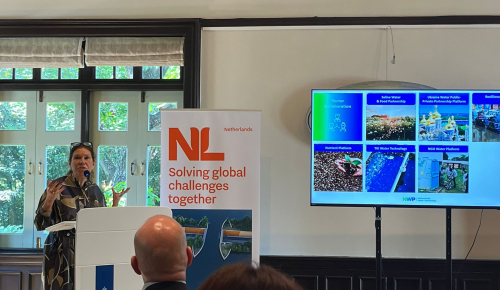
Twenty-twenty has been an important year for Blue21. Despite Covid-19 restrictions, this new member of the Netherlands Water Partnership (NWP) has managed to organise the successful Second World Conference on Floating Solutions. Under the name Paving the Waves, more than 100 people from 20 countries gathered online for three days in a row to discuss developments in floating technology. “Around the world people are seeing how they need to redefine their relationship with water,” states Rutger de Graaf, one of Blue21’s co-founders. “Floating solutions can make cities more resilient and create new ecosystems at the same time. We joined NWP so that we can help incorporate these solutions in the international Dutch delta technology ‘toolkit’.”
Initiative, design, engineering and building
De Graaf started the company, originally under the name DeltaSync, with a Technical University of Delft student group in 2007. “Our focus at the time was predominantly on the architectural and technical engineering aspects,” he recalls. “But when you are working on floating solutions, you quickly discover that, in addition to technical knowledge, you need expertise on environmental impact, business cases, legal aspects, governance and decision making.”
In 2015, the three directors of DeltaSync founded Blue21, to incorporate a much wider range of expertise. The organisation now positions itself as a ‘one stop shop’ for floating urban developments and projects. “You can hire us from the very first brainstorm right through to the actual building phase,” explains De Graaf. “Developers and companies that want to build a floating project don’t want to have to look for different partners for every phase so we make it easy for our clients.”
Towards large scale solutions
Futuristic. This is what many people think when they see images of Blue21 projects and designs around the world. However, for De Graaf and his colleagues there is nothing futuristic about their projects. “It is happening here and now,” he explains. “To some, the Rotterdam Floating Pavilion, where we have our office, is futuristic. But it was built more than 10 years ago. It is a good example of floating design and technology, be it on a relatively small scale. Our goal is to develop floating solutions at a much larger scale.”

From a technical point of view, the scale of floating solutions is unlimited. “You can make a floating suburb for 1,000 people, but you can also create a floating city for hundreds of thousands of people,” De Graaf says. The new Marin test base in Wageningen, funded by Horizon 2020’s Space@Sea research programme, is important in scaling up floating technology and solutions in maritime conditions. The combination of wave basin tests with computer-based simulations helps prove that large-scale maritime projects can be realised. De Graaf explains that “It opens the way to the sea, and that is something new. It means that we are no longer limited to the relatively small projects in protected inland waters and that we can move out to near shore locations with wave conditions. In terms of available space this opens up totally new dimensions.”

Sustainable future
Sustainable development is solidly anchored in Blue21’s vision and mission. “We want floating cities to have a positive impact on the planet,” De Graaf emphasises. “That is why the Sustainable Development Goals (SDGs) are part of our core mission. Worldwide, the SDGs are the best framework there is for a sustainable future. However, we are scientists. If we claim that our solutions are making a positive impact, we also want to prove it.
For us, this is very important,” he continues. “Floating projects are not sustainable by default. If you build floating cities in the same way as you do on land, you are not coming up with solutions, but are making existing problems bigger. Floating cities need to be designed around different ideas and values than systems on land. Technically, you can connect a floating city, its sewer systems and so on to the shore supply, but that in itself is not bringing the positive impact that we are striving for. The real challenge is to install sustainable energy supplies and water treatment plants, for instance, on site.”
Ecological impact
Blue21 has closely studied the ecological impact of floating constructions from the very beginning. “We work with Indymo (Innovative Dynamic Monitoring), which we helped set up ourselves. They are developing and applying underwater drone technology for research purposes. They help us study the impact of floatation on the underwater environment. So far, we have not seen negative impacts. And, in comparison with traditional land reclamation methods where ecological systems sometimes totally disappear because of sand fills, the perspective of floating solutions is better. We sometimes even see enrichment, for example new ecological systems that grow under the platforms.”
“Having said this, we do acknowledge that for the really big projects we simply don’t know yet,” De Graaf adds. “So along with increasing the scale of floating constructions, we need to keep on monitoring the effects. And whenever we note negative effects, we have to be ready to come up with new innovative solutions.”

Innovative Delta Technology Toolbox
Finding innovative and ever more sustainable solutions works best when working with experts from different sectors. This is why De Graaf was very pleased with the Paving the Waves conference. “One of the best outcomes was the connection we could establish between people involved in urban development on the land, the water sector, the building industry, and the maritime industry. Innovation happens where these types of sectors come together,” De Graaf observes.
Connecting to the water sector and to other related sectors around the world was the reason for Blue21 to join NWP. One immediate outcome of the cooperation was that Bianca Nijhof, CEO of NWP, delivered a keynote speech at the Paving the Waves conference (link to video). “It was a good speech,” De Graaf comments. “Bianca linked our floating solutions to the wider perspective of the Dutch delta scenarios. As we don’t know what the future will bring, we need to think in terms of scenarios and be flexible and adaptive. Not only in the Netherlands, but in all delta areas around the world that are facing similar problems too.”
This content can not be displayed.
Accept the marketing cookies to view this content.
“However you look at it,” De Graaf adds, “with our experience and expertise of living below sea level, our country has something to offer the world. I like to call it our Delta Technology Toolbox. NWP members work around the world, promoting delta technology solutions or putting them into practice. And now, with our floating solutions, I think we can add an attractive and innovative additional tool that fits very well in that toolbox.”
Featured NWP members: Blue21






